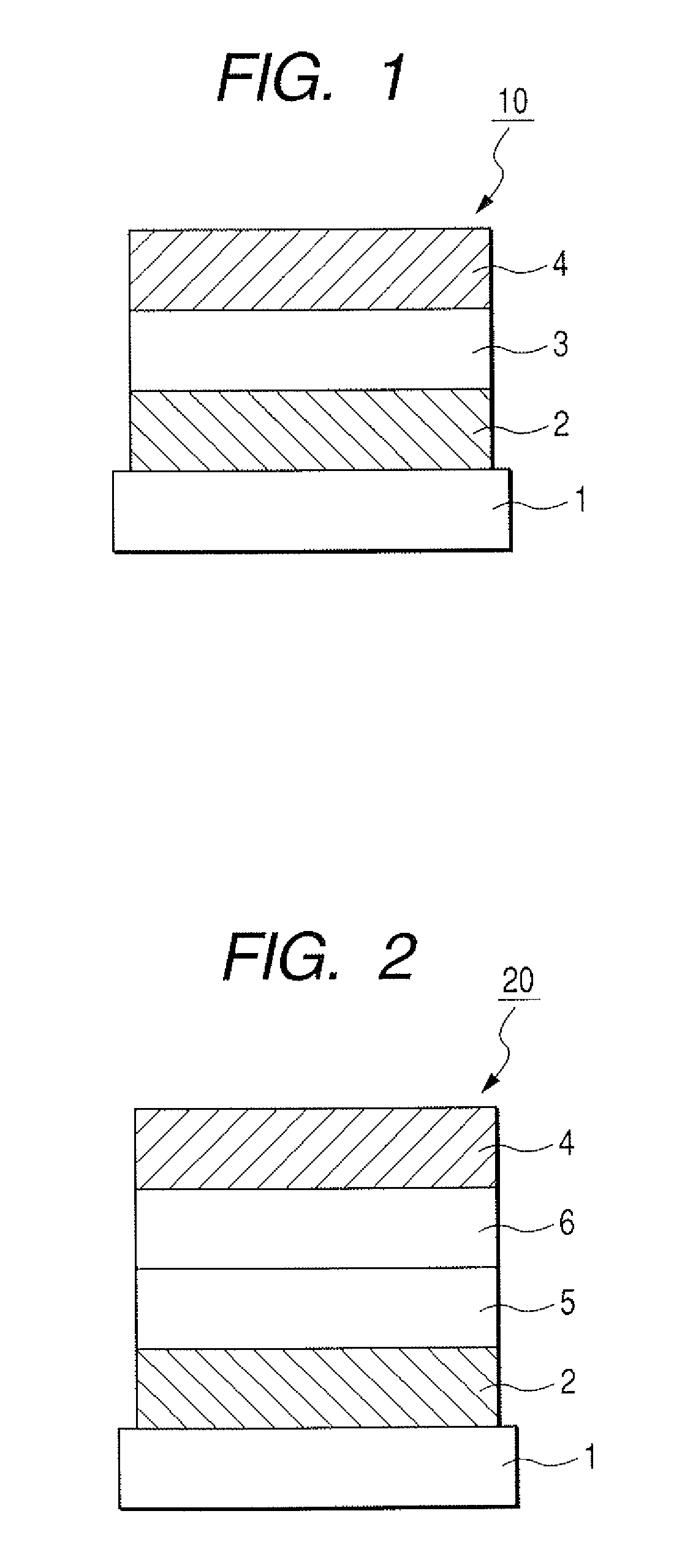Biphenyl derivative and organic light-emitting element using same
a technology of biphenyl derivative and organic light-emitting element, which is applied in the direction of group 3/13 element organic compounds, discharge tube luminescent screens, natural mineral layered products, etc., can solve the problems that the light-emitting elements having been proposed to achieve satisfactory light-emitting luminance and durability, and the organic light-emitting elements that have been proposed to achieve satisfactory luminance and durability, and achieve high luminescent optical power. high efficiency and high durability
- Summary
- Abstract
- Description
- Claims
- Application Information
AI Technical Summary
Benefits of technology
Problems solved by technology
Method used
Image
Examples
example 1
Synthesis of Exemplary Compound H-1
[0104]
[0105](1) First, 15.74 g (50 mmol) of 1,3,5-tribromobenzene (compound 1-1) was dissolved in 100 ml of dehydrated ether. Then, 34 ml (55 mmol) of a 1.60 M n-BuLi hexane solution was added dropwise over a period of 10 minutes at −78° C. in an atmosphere of nitrogen, followed by stirring for 10 minutes. Next, 7.39 g (55 mmol) of copper (II) chloride was added, followed by stirring for 30 minutes. The solution was then warmed to room temperature, and stirred for 2 hours. After the stirring, 100 ml of water was added, and the organic layer was extracted with chloroform, and then dried with anhydrous sodium sulfate. Thereafter, the solvent was distilled off under reduced pressure. Next, the resultant product was purified by recrystallization in a mixed solvent of chloroform and ethanol to produce 5.80 g of compound 1-2 (yield: 49.4%).
[0106](2) Subsequently, the following compounds were dissolved in a mixed solvent of 55 ml of toluene, 28 ml of etha...
example 2
Synthesis of Exemplary Compound H-42
[0114]
[0115](1) Reagents shown below were dissolved in a mixed solvent of 5 ml of toluene, 50 ml of ethanol and 75 ml of a 2N sodium carbonate aqueous solution. 3,5-Dibromophenylboronic acid (compound 2-1: 5.10 g (18.2 mmol); and Compound 2-2: 17.51 g (54.7 mmol).
[0116]Next, while the resulting reaction mixture was stirred at room temperature in an atmosphere of nitrogen, 0.75 g (0.65 mmol) of tetrakis(triphenylphosphine)palladium(0) was added. After that, the resultant reaction mixture was heated to 75° C., and then stirred for 14 hours. After the reaction was completed, the organic layer was extracted with chloroform, and then dried with anhydrous sodium sulfate. Thereafter, the solvent was distilled off under reduced pressure. Next, the resulting product was purified by silica gel column chromatography (developing solvent: heptane) to produce 5.94 g of compound 2-3 (yield: 76.2%).
[0117](2) Subsequently, 3.85 g (8.99 mmol) of the compound 2-3 wa...
example 3
Production of Organic Light-emitting Element
[0127]The organic light-emitting element having such a structure as shown in FIG. 3 was produced in the following way.
[0128]On a glass substrate (the substrate 1), a indium-tin oxide (ITO) film was formed as the anode 2 by sputtering in a layer thickness of 120 nm, and was subjected to ultrasonic cleaning successively with acetone and isopropyl alcohol (IPA), and then boiling cleaning with IPA, followed by drying, and was subsequently subjected to UV / ozone cleaning. The substrate with the ITO film thus treated was used as a transparent conductive support substrate.
[0129]Next, as the hole transport layer 5, a film of Compound A represented by the following formula was formed by vacuum deposition in a layer thickness of 30 nm. In this case, during the vacuum deposition, the degree of vacuum was set at 1.0×10−4 Pa and the rate of film formation was set at 0.1 nm / sec.
[0130]
[0131]Next, Exemplary Compound H-1 to be a host and Compound B represen...
PUM
| Property | Measurement | Unit |
|---|---|---|
| wavelength | aaaaa | aaaaa |
| thickness | aaaaa | aaaaa |
| thickness | aaaaa | aaaaa |
Abstract
Description
Claims
Application Information
 Login to View More
Login to View More - R&D
- Intellectual Property
- Life Sciences
- Materials
- Tech Scout
- Unparalleled Data Quality
- Higher Quality Content
- 60% Fewer Hallucinations
Browse by: Latest US Patents, China's latest patents, Technical Efficacy Thesaurus, Application Domain, Technology Topic, Popular Technical Reports.
© 2025 PatSnap. All rights reserved.Legal|Privacy policy|Modern Slavery Act Transparency Statement|Sitemap|About US| Contact US: help@patsnap.com



